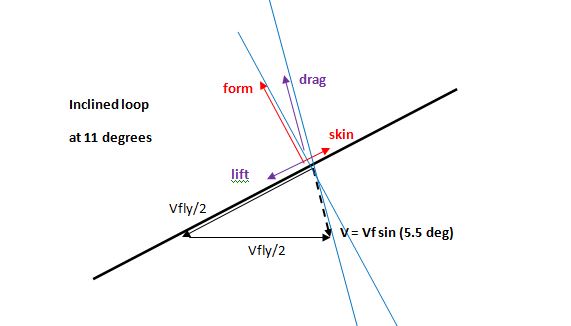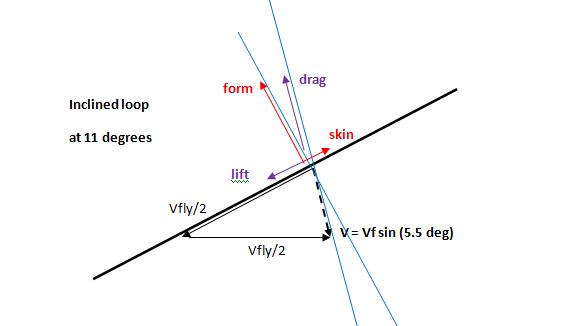Page 3 of 76
Upward Force from Form Drag
Posted: Mon Feb 12, 2018 8:57 pm
by James9118
Upward Force from Form Drag
Posted: Mon Feb 12, 2018 8:58 pm
by VGB
I think that could have been better phrased

Upward Force from Form Drag
Posted: Mon Feb 12, 2018 9:21 pm
by Lasse Karlsson
Hey, I don't speak posh

Upward Force from Form Drag
Posted: Mon Feb 12, 2018 11:39 pm
by Graeme H
I'm on your page James.
Gordy, the inclined section of the "sexy loop" is in the rod leg, correct? If so, it has no forward velocity relative to the air (on a calm day) just like the markers within the rod leg in the video I posted earlier. No forward velocity = no drag from air.
Cheers,
Graeme
Upward Force from Form Drag
Posted: Tue Feb 13, 2018 10:21 am
by Merlin
The inclined section is in the loop, Graeme.
Here is a scheme showing the forces represented along two approaches, the "form and skin" and the more conventionnal "drag and lift". I have a compatible set of assumtions for both. If I consider lift versus drag, it represents only 10% in intensity, and once projected on the vertical direction it comes down to 1%. The main component of the vertical force is thus drag.

- inclined loop.JPG (21.81 KiB) Viewed 2972 times
With a set of parameters similar to Gordy's one, I find that the vertical aerodynamic forces compensate the "loop" mass if the fly leg speed is 31.7 m/s. This is something realistic, so it could well be that the drag forces could slightly "lift" the loop is there is enough speed in the system, or maybe the inclination of the loop would change in that case and only let drag forces keep the line aloft. Bad luck we do not know the line speed for those casts.
Merlin
Upward Force from Form Drag
Posted: Tue Feb 13, 2018 5:18 pm
by gordonjudd
What causes this is, I believe, the momentum that has been imparted in to the fly-leg by the actions of the caster. Are we all in agreement on this?
James,
As you know it takes a change in momentum to produce a force, so I don't follow your argument.
I would think that sag would just get pulled out due to tension in the rod leg of the line.
Gordy
Upward Force from Form Drag
Posted: Tue Feb 13, 2018 5:21 pm
by gordonjudd
I think that lift trips off the tongue better than Fd* cos(theta) but they are not the same thing.
Vince,
So how would you compute the magnitude of the green vector in your diagram? Based on the tilt angle and the Fd magnitude of the drag force due just to form drag on the inclined section of line?
Gordy
Upward Force from Form Drag
Posted: Tue Feb 13, 2018 5:37 pm
by gordonjudd
Merlin,

I don't understand the labels on your purple "drag" and "lift" vectors in your diagram. I thought the convention for lift was it is directed in the positive y direction and drag would be in the negative x direction.
Are you showing the net skin drag direction where the upward directed skin drag on the line going around the loop (including the inclined section of line) is nearly cancelled by the downward directed skin drag force of the inclined section of line going through the air?
If the tilt angle was 11 degrees why are you using 5.5 degrees in your sind(5.5) calculation for the form drag velocity? If Vf=2*loop velocity (i.e. Vf is the fly velocity) shouldn't the form drag velocity be calculated as V//2*sind(11)? For small angle they would have about the same value, but there will be a difference when the angle is 11 degrees.
Gordy
Upward Force from Form Drag
Posted: Tue Feb 13, 2018 5:52 pm
by James9118
gordonjudd wrote:
James,
As you know it takes a change in momentum to produce a force, so I don't follow your argument.
I would think that sag would just get pulled out due to tension in the rod leg of the line.
Gordy
Hi Gordy,
And this is where we get to the crux of things. Is the transition of the fly-leg into the rod-leg lossless? When you say the 'sag would just get pulled out due to tension in the rod leg' where does that tension come from? Also the line (that's on the floor) has to be lifted and dragged along (shot) hence work is done - where does the force come from for this work bearing in mind the caster's input is over once the loop is formed?
The fundamental problem with most of these papers, in my opinion, is that they're built on false assumptions. They all start with the assumption there are no losses. The losses are absolutely fundamental to the physics of how a fly cast works, they can't just be chucked in at the end to explain why a real fly cast doesn't conform with the modelling predictions. And let's face it the modelling predictions do not reflect real life, otherwise I'd see my side casts veering to the right.
As I've previously written, I don't think these researchers know enough about the real world of fly casting, however academically gifted they are.
Cheers, James
Upward Force from Form Drag
Posted: Tue Feb 13, 2018 6:30 pm
by gordonjudd
just get pulled out due to tension in the rod leg' where does that tension come from?
James,
From the momentum flux change in the moving mass of the propagating loop. As noted before it is nominally equal to rho_l*vloop.^2.
where does the force come from for this work bearing in mind the caster's input is over once the loop is formed?
Same answer.
Is the transition of the fly-leg into the rod-leg lossless?
Falling loop experiments say that it is.
Gordy